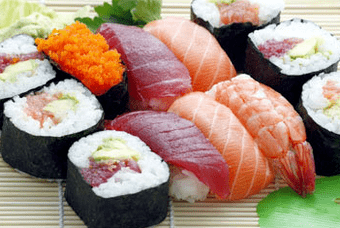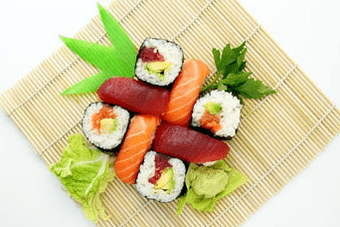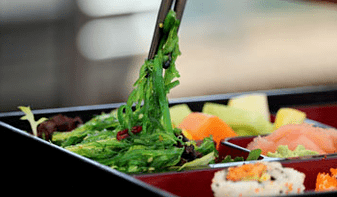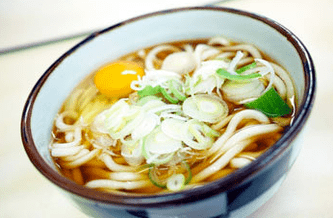The Japanese are still one of the worst people in the world.A look at their diet shows why this is how we can benefit from this.
If we want to lose weight, we often start with rigid diet, that they are not executed in a few days or weeks for each intense rule.In fact, it is so simple: Let's look at the worst people - in Japan.
Then they treat food with respect and enjoy it.

Japanese diet
Travel to Japan.Choice of products
A lotsquirrel: The main ingredients of the Japanese diet are fish, rice and vegetables.Besides soy and fruit.
On a closer examination, this is like
- rich in protein,
- Low -fat
- And the gluten -free diet.
- To fishThere are many omega-3 fatty acids that are useful.
- VegetablesThey contain the essential vitamins and fill the stomach well.
- Do not be afraid of carbohydrates: at first glance it seems that an incredible amount of white rice in Japan with ubiquitous carbohydrate phobia.Of course, this is not the fault fault.RiceThere is no gluten and there is little fat.
- Soupand fermented milk products.They hardly eat in JapanDairy products.
- Despite thatcerealSometimes they are used, for example, in the form of pasta, they are not the main food product.
- MeatThey eat much less than fish.
- But the Japanese likesEnzyme productsLike Miso or Kimchi.There are probiotics in them that are useful for the intestines.This plays a major role in losing weight.And one other thing we can take from the Japanese: they eat a lot of soup even for breakfast.
Travel to Japan.Cooking methods
In Japan, food is mainly steamed, stew or grilled.All these types of preparations are almost fat without fat.
Of course, there is also fried food, for example, common speed, but then it is used as one side dish in small quantities.In Japan, presentation and design of the dish is also important.Asian products are useful, tasty and contribute to weight loss.
In Japanese, to consciously eat
In Japan, food is considered to be an independent action that you have to focus on.Food should be eaten slowly and consciously and enjoy.Therefore, traditionally “by the way” or “go” is not eaten.That is, not during walking, or in the subway, or during the work, or when viewed on television.Of course, this is not prohibited, but, in fact, diet, especially when weight loss, should be done consciously.With this method of absorbing food, a feeling of satiety is detected.Since working days and school days in Japan can also be long, it means that there are longer breaks for food.With itpartsLess in Japan.You'll never have a plate too much with food.

The weight comes with fast food
Slow food (slow food)In Japan in the trend.If you recite this, you can lose weight deliberately, without making hunger.However, it should be noted that more and more appear in Japan from the west of new trends: Fast food, for example.The previous habits disappear in food ...
This has consequences: the Japanese also returns when they say safe with their traditional food!However, the country is fighting hard with this, Japan in 2009 took decisive measures against overweight reasons.Medical tests are carried out regularly in all municipalities and large companies.More companies should pay for medical insurance if their employees have overweight or have high blood pressure, high blood lipids or increased blood sugar.In view of these measures, many Japanese prefer to return to Miso-Supa with fish instead of toasts in the morning.
How long does the Japanese diet last?
Time and potential weight loss can be different.The Japanese diet should be observed at least four weeks.This time is enough to stimulate fat burning.There are people who have lost off3until8Kilograms in four weeks with diet.The result can be increased even more if you start a sports program.
- During the diet, many vegetables and fiber are used.The diet plan provides1200 caloriesa day.
- It is mostly intended rice, fish and vegetables.
- Drinks: A lot of tea and green water.
- Take care of fresh cooking - no finished products.
- Take sports or train for endurance.
- Plan a lot of time for cooking.
Consult a doctor.- Any changes to the diet can lead to ailments.These causes are mostly mental and due to low calorie consumption.Consult a doctor if the symptoms are preserved.
Benefits of Japanese diet
Japanese diet- This is a healthy mixed diet.Fresh products and a flat dishes are given much attention.
The disadvantages of Japanese diet
- Low calorie consumption, this can cause a feeling of hunger and malaise.For people who are overweight, the whole calorie consumption can still be too low.
- Cooking fresh wishes can be dissatisfied in the long term for those who are familiar with feeding fast food.
- Spontaneous visits have a choice on a café or restaurants with friends.
- Diet requires a lot of endurance.

But the people who finish the Japanese diet will be rewarded with more excessive weight.
If you want to see great success, make a sports program.Make sure you eat a lot of protein.Otherwise, you can not increase muscle mass.In the worst case, you will lose your muscles.Evil sports and other large loads should be avoided.
Japanese diet.Menu
All food should be fresh.These dishes are beautifully cooked, you can play with flowers.Food and enjoy food (slow food absorption) is also important.
Breakfast
- 1 Tangerine
- 1 cup of miso.This typical Japanese soup gives a lot of energy, but it is low fat.By the way, there is a fish broth, tofu, algae, miso (flavored soy paste) and green onions.The recipe below!
- 1 cup of green tea
Dinner
- 1 ground plate (raw fish with rice), with soy sauce
- a cup of noodles with mushrooms
- 1 apple
- A cup of green tea
Dinner
- 1 part of sashimi (dish of other fish), soy sauce and basabi (be careful, this paste is made of the water devil)
- 1 cup of whole grain rice
- 1 orange
- A cup of green tea
In addition, exercises (walking or riding a bike), as well as the satisfaction of simple, small things, are recommended.
And now about "Good Old Times" - Let's make a trip on time, in 1975
The Japanese are one of the most healthy people in the world who have the greatest long life expectancy, still harmful as a result of exemplary nutrition.Currently, a study has been published by Nippon.com where it justifies the reasons for Japanese good health for nutrition.Nutritions studied Japanese food habits for more than half a century.Outcome:In 1975, the highest assessments of Japanese cooking habits appreciated.
Why the Japanese diet of 1975 was considered a model of diets
For many years, the western world, particularly Japanese culture, has affected Western power in the country, and also brought diseases such as atherosclerosis and diabetes.The study in which the Japanese diet was tested on mice for several years - in 2005, 1990, 1975 and 1960.
Outcome:Mice had better health with a diet plan in Japan since 1975. This mice group had the lowest risk of diabetes and healthy aenna.
Objective:There was a higher percentage of vegetables, fruits, seaweed and seafood in this particular year in the Japanese average diet plan.In addition, in 1975, the diet was a variety of fermented spices and a variety of herbs.In addition, the consumption of juices and soft drinks sugars was not as common in Japan at the time today - both drinks are considered unhealthy in large quantities.
After a 48 week study period, the researchers found that the Japanese diet mice 1975 fed more slowly and had a better memory than mice on a 2005 diet.
But can these results be transferred to people?A study conducted by the University of Tohoku University Research Committee in Sendai, Japan, "Research Ethics Committee" der Tōhoku Uni, Sendai, showed that the 1975 diet has the same beneficial effects in humans.And the group of participants who followed 1975 diet over 28 days were better than those who followed the 2005 eating plan. In the first group, cholesterol levels were lower, as the risk of diabetes.When an hour's exercise was accompanied by three times a week, 1975 diet reduced stress levels and an increase in perseverance in a group of 20 and 30 years of age.
In summary, we can say thatJapanese Food 1975Compared to new eating in Japan - and Western typical eating habits today - it is healthier in many ways.The lifestyle and diet reduce this risk of diabetes, cholesterol levels in the long term, reduces blood lipids and aggressive fat, weight loss is a positive sub -effect.

1975 diet, together with regular physical exercises, adds to weight loss.
- Variety:A daily menu usually consists of many different dishes served with soup and rice - instead of one big main dish.
- Preparation:The three most common types of dishes prepared in 1975 were boil, steamed or raw, also grilled.Heat freedom and roasting were not used as often.This preparatory form is the result of the fact that the most important nutritional values are lost in the heat.For example, the oily fish contain important omega-3 fatty acids.After frying, there is only one third of the initial fat in the fish compared to raw fish, such as sashim.
- Ingredients:1975 diet is the rich in soy products, in seafood, tubers and green and yellow vegetables (including rnicons), fruit, algae, mushrooms and green tea.Eggs, dairy products and meat were also consumed in 1975, but in moderate quantities.
- Spices:Instead of salt and sugar for taste, soy sauce, vinegar and sake, fermented spices and fish broth are used.
Miso soup- This is a Japanese national dish, preparing quickly and the aromatic.The main recipe contains few ingredients - you can enrich it as you like.Often abused breakfast in Japan, but also as a snack dish or side.With filling, the soup is the main dish.
As a basis for soup, you will need only two components:
Mizopasta:This spicy paste consists of soybean and - depending on a variety - different cereals, such as rice or barley.The ingredients are fatal and fermented in barrels with the help of a coji model.Miso pass is light and dark, sweet and sour.Therefore, the choice of miso soup has a major impact on the choice of diversity.Mizopasta is considered very useful because there are probiotic lactic bacteria during fermented.Dasha:The Japanese fish broth is prepared from the seaweed combat and dried bonito flakes (mackerel type or tuna: “Katsuo-Bushi”-“Katsuo-Busi”).If you want to cook a vegetarian Miso soup, you can use dried shiitaka and possibly mushrooms of Maitaka or Enoki instead of bonito flakes.
Miso Soup: Basic Recipe
For four small parts of the MISO soup, you will need the following ingredients:
- 750 milliliters of Dasha
- About two or three tablespoons of miso-poster
Use the miso-potte of your choice: as well as soy, there is rice in Shiro-Miso and has a relatively soft and sweet taste.These darker varieties of miso, such as Genmai or Hatcho Miso, are more interesting.
How to cook a miso soup
-
Heat broth dasha - but not cooking.
-
Skip the pass-pass through the sieve and mix well with the broth.First of all, only part of the quantity is used, since Paste Miso has a salty taste.Try soup, and then add more to Miso Pastes, if necessary.
-
Add the ingredients of your choice in abuse in a few minutes before you serve.Serve the finished soup in bowls.By the way, in Japan, the soup is eaten with sticks for food, and then the broth is drunk from the cup.
Miso soup prescription: additives and tasting
For your soup, you can prepare different ingredients.In Japan, the attention is given to the fact that the ingredients are evenly cut -so the finished soup looks beautiful.Here are a few examples to enrich your month -lion:
- Rice or cooked paste (for example, buckwheat dog noodles)
- Tofu sliced by cubes
- Green onions or onions, cut into thin rings
- Mushrooms, fine chop
- Kohlarabi, finely chop
- Snow sections
- Leaf spinach, park park or mangold
- Roasted vegetables such as broccoli, peppers or carrots

Although miso soup itself is the -spicy, it can be flavored with some spices.For example:
- Soy sauce
- Small lime juice
- Japan's Worcestershire sauce
- a few drops of sesame oil
- Some ginger powder and/or chili.
- You can slide fresh ginger and/or chili peppers into thin slices and leave them in the soup.
Advice:For many of the ingredients you will have to go to the Asian store, but at regional markets you can buy fresh leeks, mushrooms, kohlrabi and Co..
Tofu and other soy products are now produced in other countries.
JapaneseEat:
- rice, fish (raw and cooked), vegetables, soy and seaweed
- Small parts
- Different foods (up to 30 different per day)
- For breakfast soup, fish, rice, vegetables
- Unprocessed fresh seasonal foods
Almost don't eat desserts than eat bread
Drinking mostly green tea
Do not fry in oil, only use a small vegetable oil for frying
Walk and bike enough
The top three products
Rice/fish (seaweed)/soy (tofu)
Drink: green tea
And one other resolution from Japanese women
Do you want to be 12 cm thinner at the waist?- If so, then do the following breath exercise!
Important!
- Do it daily!
- Make it before breakfast!
- Never rush!
- Put your feet behind the other side comfortable.The generations are “looking forward naturally.
- Change your body weight to your rear foot and straighten your front leg.
- Inhale for 3 seconds.
- Exhale for 7 seconds.Relax your muscles.Put your hands down.
Repeat the exercise for 3 minutes at the beginning, then increase the time to 10 minutes.














































































